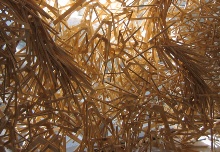Computation is in principle the processing of information. It can be based on digital as well as analogue processes. In this seminar, the design methodology of Material Computation is introduced as a form of analogue computational modeling using aggregate systems as the medium of investigation. Aggregates are defined as large amounts of elements which lie in loose contact with each other. In the building industry, they mainly serve as additives in concrete construction. There are relatively few examples which utilize aggregates in their unbound form.
The aim of the seminar has been to investigate the architectural potential of aggregates using analogue computational models. The notion of loose elements as an architectural system in their own right is novel and presents a relatively unexplored design approach in architecture. Architectural systems commonly seek to form a clearly defined assembly of elements, where each part has a specific placement which can be planned by the designing architect. An Aggregate System however consists of a loose arrangement of elements, where each part continuously finds its own place and the task of the designer is to merely observe and interact with the system. The relevance of these Aggregate Architectures lies in their ability to continuously adjust to system-external and system-internal parameters. In the seminar the notion of Aggregate Architecture has been introduced on a practical, methodological and theoretical level. Analogue models were used to observe specific aggregate behaviours and to investigate them with regards to their architectural relevance.
Material Computation: Aggregate Architectures - Project 01


